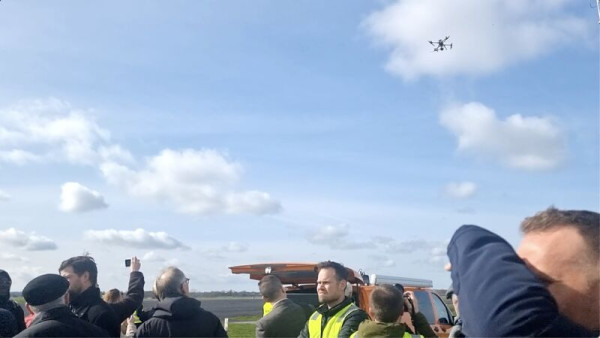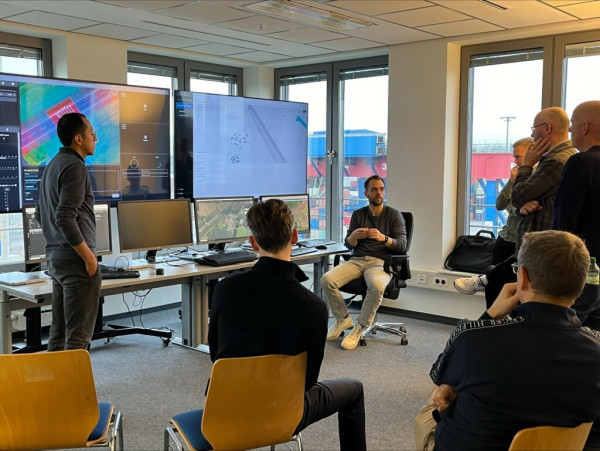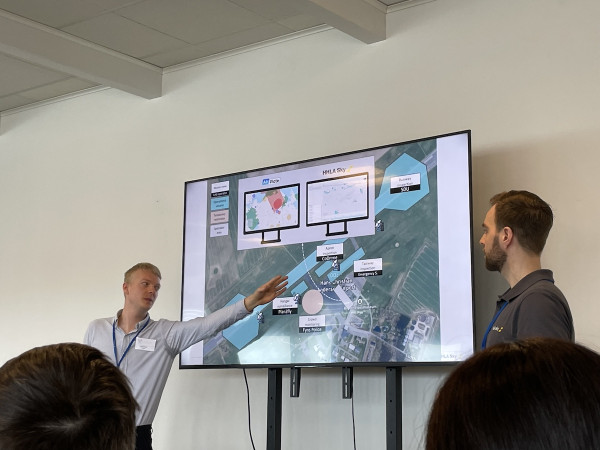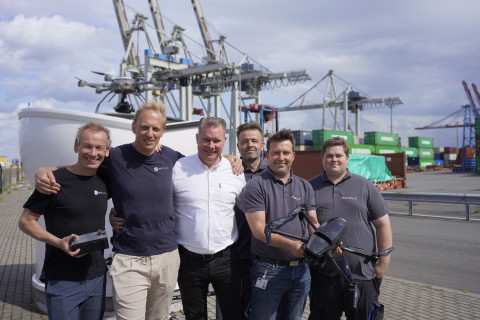GENIUS Project: Demonstrating U-Space in Action

A sandboxed U-space in a live demonstration at the Hans Christian Anderson Airport in Odense, Denmark: This spectacular project completion had a three-year history and many partners with many ideas involved in its success. Here is the story:
The GENIUS project focused on one of the leading barriers to the widespread adoption of drones across Denmark and the EU: the lack of communication infrastructure that can meet U-space requirements. Overcoming this obstacle is vital in allowing drones to provide their much-needed value in increasing productivity and efficiency across various industries and applications.
This sparked the mission, led by project coordinator SDU, to enable drones to fly side by side with manned aviation. For this to be successful, a U-space test environment, needed to be established to safely and reliably manage drone operations and manned aircraft in a shared airspace. This also include testing a secure 5G lower airspace communication network.
The project successfully concluded in March 2024, after commencing in 2021, following a successful three-year Grand Solutions research project funded by Innovation Fund Denmark.
Let’s take look at what the project achieved thanks to the partners expertise and the fruitful collaboration…

GENIUS Partners and Their Involvement in the Project
GENIUS brought together partners from across the industry and research to contribute to different components of the project:
- SDU UAS Center coordinated the project, providing expertise in drone research and development.
- TDC Net and Ericsson, respective leading infrastructure providers, worked closely to develop and provide a reliable 5G network with 3D coverage for drones.
- DTU, with its focus on communication systems and experience with computer simulation of communication systems, contributed with a 3D mobile coverage model.
- AirPlate, a spin-out start-up from the GENIUS project, developed a cost-efficient standalone drone tracking device utilizing 5G for drones to comply with remote identification in U-spaces. AirPlate worked closely with HHLA Sky to integrate AirPlate’s remote identification with HHLA Sky’s UTM system.
- MECK consult advised on UAS regulatory
- Science Ventures Denmark supported the commercialization of research and findings.

HHLA Sky’s Role in the GENIUS Project
HHLA Sky joined the GENIUS Consortium in 2023 to provide UTM technology and act as a U-space Service Provider (USSP).
HHLA Sky’s UTM technology was integrated with AirPlate’s remote identification devices, plus aircraft surveillance provided by SDU.
Alongside Ericsson, TDC, and DTU, the GENIUS project explored the integration of HHLA Sky’s UTM systems with 5G-enabled services, such as mobile coverage and network slicing.
Innovations from the GENIUS Project
Over the course of the three years, the collaboration efforts showcased how a U-space could be successfully implemented on a 5G network. Ericsson and TDC NET demonstrated the real-time observability of drones, implementations of a SIM density map, as well as in-field verification of Ericsson’s 3GPP Real-Time Kinematics technology.
The collaborators of GENIUS were able to test and validate in real-world scenarios, demonstrating the integration of U-space services with drone flights over 5G. With HHLA Sky’s Integrated Control Center (ICC), multiple drone operations were planed and operated in a sandbox U-space airspace seamlessly.

U-space in Action: The Live Demo of the GENIUS Project
In April 2024, the project presented a live demonstration at Hans Christian Andersen Airport.
The GENIUS partners sandboxed a U-space airspace where five drone operators safely operated their planned missions. The demonstrated UTM capabilities of HHLA Sky included temporary airspace restrictions, flight authorizations, network identification enabled by AirPlate’s hook-on device, and conformance monitoring, which automatically checked whether a drone was flying according to its flight authorization.
This final demonstration marked a milestone for U-space, serving as a successful display of how drones can safely and reliably operate in shared airspace.
We thank our fellow GENIUS partners for their hard work over the last three years and look forward to continuing to strive towards full adoption for the industry: coordinator University of Southern Denmark between the partners AirPlate, DTU - Technical University of Denmark, Ericsson Telecommunications, MECK Consult, SDU Robotics, Styrelsen for Dataforsyning og Infrastruktur, TDC NET.
Learn more about U-space Realization in Europe
Discover more about the results of the GENIUS project: genius.aero/results
GENIUS project member Ericsson about the capabilities of the 5G drone technology, previously shown at the International Drone Show 2023 in Denmark.
HHLA Sky on the contributions of the GENIUS project to U-Space and the follow-up project BLU-Space.
HHLA Sky’s follow-up project BLU-Space is developing and testing a blueprint system for U-spaces in Hamburg, Germany.
Media on the GENIUS project
VDI nachrichten, Germany's leading weekly newspaper for engineering and technology developments and related business trends, featured a report on how 5G technology is enabling the integration of drones into airspace. For the full story, check out: https://www.vdi-nachrichten.com/technik/mobilitaet/wie-5g-die-integration-von-drohnen-im-luftraum-ermoeglicht/
"The future of drone technology hinges on their integration into shared airspace, where they can safely operate alongside manned aviation.", Drone Life magazine highlights in its report about the significance of 5G technology for safe drone traffic management in shared airspaces: https://dronelife.com/2024/08/21/5g-technology-paves-the-way-for-drone-integration-into-danish-airspace/


